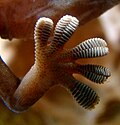Lizard
Lizards are a widespread group of squamate reptiles, with sizes ranging from tiny geckos and anoles to the large Komodo dragon. Most lizards are quadrupedal, running with a strong side-to-side motion. Others are legless, and have long snake-like bodies. Some such as the forest-dwelling Draco lizards are able to glide. They are often territorial, the males fighting off other males and signalling, often with brightly colours, to attract mates and to intimidate rivals. Lizards are mainly carnivorous, often being sit-and-wait predators; many smaller species eat insects, while the Komodo eats mammals as big as water buffalo.
Taxonomy and classification[edit]
Lizards are classified as part of the Squamata order of reptiles, which also includes snakes. They are further divided into multiple families, such as the Agamidae (dragon lizards), Gekkonidae (geckos), and Varanidae (monitor lizards), among others.
Anatomy and physiology[edit]
Lizards typically have feet and external ears, while many lizards can detach their tails to escape from predators. They have a high metabolic rate from among the reptiles. Many lizards also have well-developed visual depth perception and keen eyesight, making them skilled hunters.
Behavior[edit]
Lizards employ a variety of behavioral adaptations, including territorial behavior, parasitic behavior, and in some species, a form of social organization. Many species are also known for their ability to "play dead" or "freeze" in the presence of a threat.
Reproduction[edit]
Most lizards lay eggs, with some species being ovoviviparous (giving birth to live young). Many lizards also exhibit various forms of parental care, with females guarding their nests and young.
Conservation[edit]
Many species of lizards are threatened by habitat loss, pollution, and introduced species. Conservation efforts are being made worldwide to protect endangered lizard species.
See also[edit]
References[edit]
<references />
|
|
|
Lizard[edit]
-
Lizard Collage
-
Mediterranean house gecko
-
Red Tegu Skull
-
Gecko foot on glass
-
Nile Monitor (Varanus niloticus)
-
Bearded Dragon Skeleton
-
Gila Monster
-
Trachylepis maculilabris mating
-
Eastern Fence Lizard Egg
-
Fighting Sand lizards (Lacerta agilis)
-
Green anole
-
Oriental Garden Lizard
Ad. Transform your life with W8MD's Budget GLP-1 injections from $75


W8MD offers a medical weight loss program to lose weight in Philadelphia. Our physician-supervised medical weight loss provides:
- Weight loss injections in NYC (generic and brand names):
- Zepbound / Mounjaro, Wegovy / Ozempic, Saxenda
- Most insurances accepted or discounted self-pay rates. We will obtain insurance prior authorizations if needed.
- Generic GLP1 weight loss injections from $75 for the starting dose.
- Also offer prescription weight loss medications including Phentermine, Qsymia, Diethylpropion, Contrave etc.
NYC weight loss doctor appointmentsNYC weight loss doctor appointments
Start your NYC weight loss journey today at our NYC medical weight loss and Philadelphia medical weight loss clinics.
- Call 718-946-5500 to lose weight in NYC or for medical weight loss in Philadelphia 215-676-2334.
- Tags:NYC medical weight loss, Philadelphia lose weight Zepbound NYC, Budget GLP1 weight loss injections, Wegovy Philadelphia, Wegovy NYC, Philadelphia medical weight loss, Brookly weight loss and Wegovy NYC
|
WikiMD's Wellness Encyclopedia |
| Let Food Be Thy Medicine Medicine Thy Food - Hippocrates |
Medical Disclaimer: WikiMD is not a substitute for professional medical advice. The information on WikiMD is provided as an information resource only, may be incorrect, outdated or misleading, and is not to be used or relied on for any diagnostic or treatment purposes. Please consult your health care provider before making any healthcare decisions or for guidance about a specific medical condition. WikiMD expressly disclaims responsibility, and shall have no liability, for any damages, loss, injury, or liability whatsoever suffered as a result of your reliance on the information contained in this site. By visiting this site you agree to the foregoing terms and conditions, which may from time to time be changed or supplemented by WikiMD. If you do not agree to the foregoing terms and conditions, you should not enter or use this site. See full disclaimer.
Credits:Most images are courtesy of Wikimedia commons, and templates, categories Wikipedia, licensed under CC BY SA or similar.
Translate this page: - East Asian
中文,
日本,
한국어,
South Asian
हिन्दी,
தமிழ்,
తెలుగు,
Urdu,
ಕನ್ನಡ,
Southeast Asian
Indonesian,
Vietnamese,
Thai,
မြန်မာဘာသာ,
বাংলা
European
español,
Deutsch,
français,
Greek,
português do Brasil,
polski,
română,
русский,
Nederlands,
norsk,
svenska,
suomi,
Italian
Middle Eastern & African
عربى,
Turkish,
Persian,
Hebrew,
Afrikaans,
isiZulu,
Kiswahili,
Other
Bulgarian,
Hungarian,
Czech,
Swedish,
മലയാളം,
मराठी,
ਪੰਜਾਬੀ,
ગુજરાતી,
Portuguese,
Ukrainian














